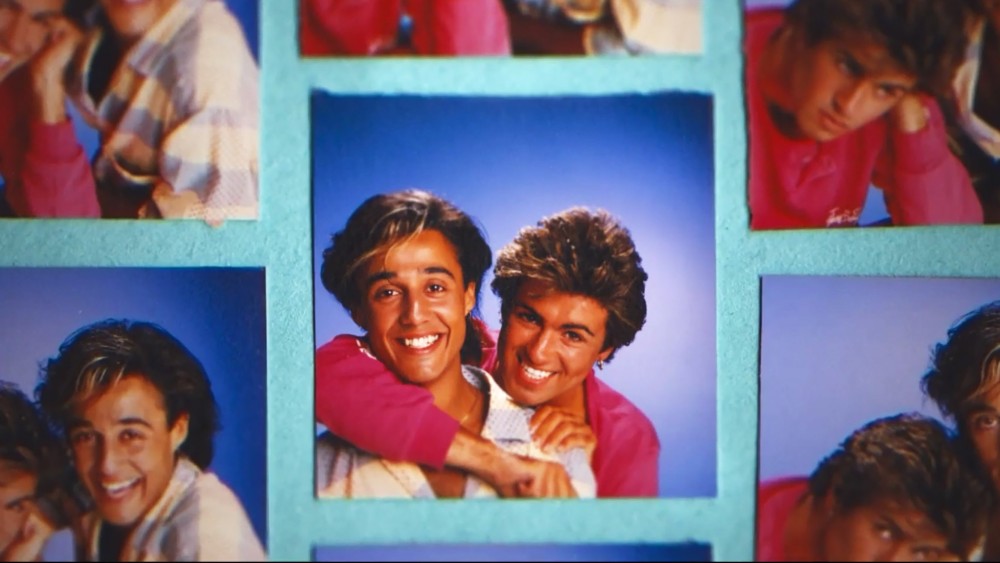
Unabashed pop groups with fervid teenage followings tend to get trivialized, at least in the media. They’re dismissed as being slick and calculated and superficial. But there’s a story in “Wham!,” the new Netflix documentary about the quintessential pop duo of the 1980s, that testifies to what a chancy and audacious artist George Michael was even back in his teen-idol days.
The year is 1983. Michael and Andrew Ridgeley, coming off their first album, “Fantastic” (which had a few hits, though none of them were great), have established Wham! as an effective lightweight pop machine, with its two young stars prancing around the stage in sexy sportswear. The time has come to record “Careless Whisper,” a song they’ve had in their back pocket for several years (we hear the super-early demo version of it that they recorded in 1981 in Ridgeley’s living room on a TEAC 4-track Portastudio). Michael has become enough of a powerhouse to hook up with Jerry Wexler, the legendary producer of Aretha Franklin and Ray Charles. He heads down to Muscle Shoals Sound Studio to record the track, with Wexler producing. What more could a 20-year-old budding pop star want?
But we hear the version that Wexler produced, and despite a certain craftsmanly elegance it’s weirdly cut-and-dried. George Michael didn’t like how the song sounded (neither, it turns out, did Wexler). So he decided to redo the track and produce it himself. By the time Michael settled on Steve Gregory to play what became the song’s iconic saxophone solo, he’d already tried out the riff with 10 different sax players. That’s how much he knew what he was searching for. “Careless Whisper,” of course, is a lovely song, but what makes it indelible is the swing, the lilt, the invisible surge beneath the melancholy. That’s what the Wexler version was too staid to give life to, and it’s what George Michael, as a recording artist, breathed into it.
“Wham!,” directed by the ace documentarian Chris Smith (“Fyre,” “Jim and Andy: The Great Beyond”), presents itself as a light and lively scrapbook of an irresistible pop moment (the movie literally uses the 30-volume scrapbook of Wham!’s career compiled by Andrew Ridgeley’s mother as an organizing diary). If all you want from the film is a kind of nostalgic pep pill, a fizzy revel in the bubblegum glory of its subject, you’ll find that the movie totally scratches than itch. But “Wham!” is also a fascinating music documentary that’s telling two stories at once.
The first is the catchy effervescent saga of Wham!, from their initial stumble out of the gate (when they released their first single, “Wham Rap,” in 1981, it didn’t even crack the top 100 in England) to the way that they were rescued, on Nov. 28, 1982, by “Top of the Pops,” the iconic British TV show that invited them to perform at the last minute, because another band had dropped out. We see that appearance: George Michael, bare-chested under a brown leather vest, singing “Young Guns (Go for It!),” which is not a particularly good song. Yet the look! The dancing! The ecstatic exuberance! That was all it took. The single flew up the charts.
Yet the other story the film tells is about the rise of George Michael as a solo artist. And the reason that story is so central to the saga of Wham! is that Michael, we can see in hindsight, was forging that identity from the outset.
He took control of the recordings. He took control of the songwriting (Ridgeley, who had a lot to do with creating the group’s image and spirit, knew Michael excelled in that department and had no problem letting him run with it). And he took control of investing their teenybop aura with something that was, in the infectiousness of its sound, ineffably richer. The truth is that where “Faith,” the defining solo album that Michael released in 1987, was greeted by the world as the launch of George Michael as a “mature” pop star, the songs on “Faith” weren’t appreciably different from the best Wham! songs. The lyrics (notably on “Father Figure”) were a little more serious. But if you listen closely, you can hear that George Michael was already, in the heyday of Wham!, a mature pop star. He just wasn’t packaging himself that way.
The development of the George Michael look and persona is telling, because part of the tale of pop music is that so many great artists also had the karmic DNA to hit the beauty jackpot, and in Michael’s case, during the Wham! years, we literally see him develop from a slightly awkward and blobby teenager into the dreamboat he made himself into. The documentary’s soundtrack is threaded with old interviews with Michael and Ridgeley, who narrate the film. At one point we hear Michael say it surprised him that he could become “the kind of pin-up that Andrew so obviously was.” That sounds like false modesty, but I totally believe him, because it’s borne out by what we see.
The two met in 1975, when they were 11 and 12. Michael, then known by his Greek name, Georgios Panayiotou, joined Ridgeley’s class at the Bushey Meads School in Hertfordshire, where he was a total geek, with glasses and curls and a stare of moon-faced woe. They planned their pop assault from an early age, but by the time they were in their late teens, Michael, now in a leather jacket, still had a slightly raw big-boned adolescent geekiness about him. He wasn’t nearly as handsome as he would be a couple of years later. Whereas Ridgeley was all svelte cuteness.
Then again, from the Beatles with their moptops to Little Richard and his pompadour to Bowie and his glam alien rooster façade, pop stars aren’t just born that way. They need to invent their images, and in George Michael’s case what he did with his hair was paramount. It started off as a dark mop, but there are certain individuals who, when they go blond, transform their souls. Norma Jean Baker had personality and wit and sexy beauty to spare — but could you begin to imagine Marilyn Monroe if she wasn’t blonde? In a funny way, George Michael was the same. When he got those frosted highlights and grew his hair longer, it completed him. He was now a golden god. (He also had the rare face that looked sleeker with a beard.)
Around the same time that he was producing “Careless Whisper,” Michael wrote and produced “Wake Me Up Before You Go-Go,” an epiphany of a song when you consider its guilty-pleasure way of sneaking up on you. In the tribute to George Michael I wrote when he died, I traced my own journey with that song — how in the ’80s, it always struck me as overly chipper and a bit insipid, but when I began to hear it on movie soundtracks I realized that for everything about it you could make fun of, the song had a frisky incandescence that just wouldn’t quit. It kicked. And that was all about the way George Michael produced it.
The great Wham! songs have a kinesthetic quality that connects with you like a hidden spice. We see Michael shaking his booty on stage, in his CHOOSE LIFE shirt, to “Wake Me Up…,” and it’s a different George Michael, now fully liberated. When does unabashed pop become something more than “superficial”? When it’s this bubbling over with its own bliss. The spirit of Wham! was something obvious yet ineffable. You hear it in “I’m Your Man,” a song that in other hands could have been simply catchy and disposable. But when you listen to Wham! do it, something about it — the propulsion, the bounce, those plonking chords, the soar of Michael’s singing — creates a powerful chemical reaction.
The film captures how much Michael was tormented by the drive to hide his sexuality. Wham! was already launched when he came out to Andrew Ridgeley, and as the group got bigger, the disconnect between Michael’s public image and his private reality became, for him, a chasm of emotional instability. He flirted with outing a certain dimension of himself in the lyrics to “Freedom.” Yet it remained a form of code.
And that was connected to his primal ambivalence about fame. Being famous overwhelmed him, yet he’s candid about the consuming need his “ego” had for him to be nothing less than a number-one pop star. This becomes most dramatic during the recording, in 1984, of “Do They Know It’s Christmas?” The whole point of the song was to be a big hit and raise money for the famine in Ethiopia, yet Michael admits that all he could think about was his obsession with the prospect of “Last Christmas” (which was about to be released) becoming Wham!’s fourth number-one single of the year — and how that grand plan would likely be wrecked by “Do They Know It’s Christmas?” (It was. “Last Christmas” had to ride it out at #2.)
There’s no rancor to speak of in “Wham!” The Andrew Ridgeley we see is fully supportive of George Michael going off on his own. Maybe that’s because Ridgeley, though he went through a party-boy phase that was splashed all over the tabloids (who dubbed him “Randy Andy”), was intelligent and non-egomaniacal enough to realize that Wham!, as a group, was 90 percent George Michael and 10 percent him. No pop star in history was ever meant to go off on his own more than George Michael. In that sense, there was nothing tragic or even sad about the breakup of Wham! The tragedy was that Michael fell apart after releasing “Listen Without Prejudice Vol. I.” He created his greatest song, “Freedom! ’90,” then faded into a conflicted haze of ego and self-doubt. But that’s another story. The one that “Wham!” tells coasts along on a nearly undiluted current of joy.













